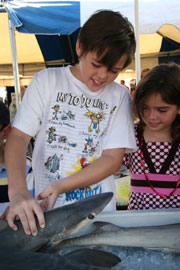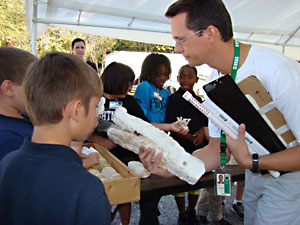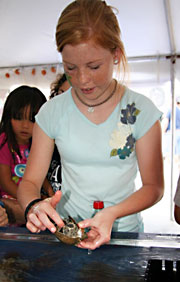 |
||||||||
Reawakening the Scientific Mind of the American Public
By Matthew Cimitile

Courtesy Florida Fish and Wildlife Conservation Commission (FWC).
Two young visitors check out preserved sharks at MarineQuest 2009.
Two major pieces of domestic legislation undertaken by the Obama administration and Congress deal with health care and climate change. They look to reform outdated systems of how we care for and cover human health and how we use natural resources — fossil fuels, alternative energy, forests and water — in the face of warming temperatures and a changing world. And both are heavily steeped in the 21st century world of science.
From basic electrical and water services to the latest online anytime email delivered wherever we are, Americans depend upon science and technology to maintain and improve our quality of life. But even as we become more dependent upon technology, our grasp of basic scientific principles is slipping.
“Science literacy nationally has been declining over time. We are not keeping pace with international competitors and there is a decline in youths going into science fields,” said Sheri Potter, network project manager for the Coalition on the Public Understanding of Science, a grassroots organization made up of universities, museums and government agencies.
A national survey commissioned by the California Academy of Sciences in 2009 revealed many Americans have trouble with basic scientific concepts. Of the 1,000 adults polled, nearly half (47%) did not know how long it takes the Earth to revolve around the Sun. Two in five believed the earliest humans lived at the same time as dinosaurs and a slight majority (53%) could not roughly approximate what percentage of Earth was covered by water. The declining trend has been well documented by other studies.
In a report published a year earlier, the Organization for Economic Cooperation and Development (OCED) concluded American teens scored below average in international comparisons of science and math literacy, ranking American 15 year-olds 29th among 57 countries mostly in Europe and Asia.
Further adding to the nation’s science education woes is the government initiative No Child Left Behind. Though the program was created to improve student performance in math and reading, it has taken time away from teaching of science in elementary schools, according to a Center on Education Policy report.
The wise use of science and technology in such things as health, security and natural resources development — especially in a democratic nation — requires significant understanding from citizens in these fields. “It is important for the public to be scientifically literate because they are the decision makers in our society,” Potter said. “The public is the voting constituency who makes decisions on policy and ensures that we have quality education systems.”
Take climate change. Coming to terms with this cause-and-effect process requires that the public understand large earth processes and global systems such as the greenhouse effect, greenhouse gases, alternative sources of energy and the conservation of water and vulnerable ecosystems. A grasp of scientific processes and methods makes it easier to develop choices about reduced risk, public safety and resource sustainability. With these tools, the public can then make insightful decisions that support or condemn policies such as offshore drilling or carbon cap and trade.
In addition to national decisions, science literacy creates a more sophisticated work force. Highly skilled labor is necessary in a more technological world, not just to innovate but to compete with other nations on the world’s market for jobs in alternative energy, engineering and various scientific fields.
“The direct benefit of science literacy to the individual will be better employment opportunities today and in the future,” said Gerry Meisels, a chemistry professor and director of the Coalition for Science Literacy at the University of South Florida (see related story).
Following the Trend
Florida is a microcosm of the science literacy troubles seen nationwide. In 2005, Florida was one of 15 states that earned an F mark by the Fordham Institute for its K-12 science standards.
“Florida remains below average in science literacy in comparison to other states and with the way the economy is, it is hard to get the commitment necessary to improve on the status quo,” said Meisels.
Still, some slight signs of progress can be seen. Science scores on the FCAT have steadily climbed in grades 5, 8 and 11 since 2003. Florida’s science and math standards were revised in 2008 to meet top national standards, focus more on major scientific topics and emphasize critical thinking and problem-solving approaches to learning rather than memorizing science terms and definitions.
“The new standards set a target – they are a roadmap that is useful because they concentrate much more on depth and squarely address major scientific issues such as diversity and the “E” word, evolution,” Meisels said. “Now we need teachers to effectively meet these standards and develop thought processes in students rather than teach memory-based science.”
Sparking Interest


Teaching and communicating science is just as much about engaging people’s curiosity and creativity as it is about understanding equations. So while higher state education standards hope to guide students towards better achievement, a community of scientists and environmentalists in Tampa Bay are sparking people’s natural scientific curiosity. Organizations ranging from the Tampa Bay Estuary Program and MOSI to Tampa Bay Watch and the Southwest Florida Water Management District are developing programs that provide teachers, students and the public with new ways of inquiry that focus on hands-on experiences that trigger a desire for more knowledge.
For example, the “Ground Water Institute for Teachers” developed by American Ground Water Trust has been educating teachers about water issues for 10 years. A recent workshop hosted by The Pier Aquarium in St. Petersburg taught middle and high school science teachers the fundamentals of hydrology and geology, relating these science topics to real environmental issues of local interest.
“The institute training program provides teachers with information about the ways in which science and technology are helping to solve practical water resources issues. Many of our students know more about exotic subjects such as dinosaurs and volcanoes than about the origins of local sources of water supply. We use hands-on approaches with the teachers so they in turn can present the information in an exciting way while getting through the importance of the subject to students,” said Andrew Stone, executive director of AGWT.
Other programs work directly with students, like those created by Tampa Bay Watch. Its “Bay Grasses in Classes” program establishes salt marsh nurseries at middle and high schools throughout Hillsborough and Pinellas counties. Students help to restore habitat and become familiar with the variety of animals that depend on them, said Martha Gruber, an environmental scientist at Tampa Bay Watch.
“We saw a need for community events to take place in the area and the logical next step was to involve the youth,” said Gruber. “Since we started keeping track in 2001, the schools we have worked with have restored over 92 acres of salt marsh wetlands.”

Another way to improve science literacy is to hold events where scientific topics are accessible for public interaction. Two big events in downtown St. Petersburg that share science with the community are the Florida Fish and Wildlife Research Institute’s Marine Quest April 15 to 17 and the US Geological Survey Open House held in November. Both events serve up science in a friendly atmosphere where scientists interact personally with the public, including school children. Participants come face to face with coral reefs, alligators, hurricanes, tsunamis and the wildlife and geology in their backyard. The experience generates inquiry and an appreciation of how science affects everyday life.
“It’s not only important to go out there and do the science, but as important is to communicate what the science tells us and how it provides vital information to make everyday decisions,” said Ann Tihansky, information specialist at the USGS in St. Petersburg.
The FWRI’s annual Marine Quest includes two days of interactive programming for schoolchildren, followed by a Saturday event open to kids of all ages. “It’s a matter of awareness,” says Luiz Barbieri, FWRI’s director of research. “If people understand the issue and relate to it, they’re going to be more active in conservation efforts.”
A new twist in Tampa Bay connects scientists with the public on topics of common interest at science cafés. Designed to create a casual atmosphere where informal science education can take place, science cafes now have huge networks globally. Locally, the St. Petersburg Science Cafe is hosted by the Pier Aquarium and sponsored by the University of South Florida College of Marine Science, the American Chemical Society and WGBH Educational Foundation to bring a curious public, scientists and an intriguing topic for conversation together.
“It’s a water cooler conversation about science, a way to make it easy for people to learn scientific concepts,” said Emily Stehle, marketing director for The Pier Aquarium. “Hopefully they are getting a healthy understanding that science relates to their everyday life and science isn’t something that is just found in a newspaper or seen on TV.”
In an age where almost everything is intricately linked with science and technology, the importance of educating, engaging and captivating the public’s mind in science has never been greater. Endeavors to improve science literacy among the public will need to continue. Supporting efforts already underway will spark interest and reignite the natural scientific curiosity and wonderment within us all.
